
View of Oldupai Gorge. (889k)
I have visited three main sites where human ancestors were discovered, Ethiopia, Olduvai Gorge in Tanzania, and Sterkfontein in South Africa. Here are descriptions of the three sites and some pictures.
The sites with human ancestors are more examples of sites of Ancient Civilizations that I visited during my travels.
All pictures are © Dr. Günther Eichhorn, unless otherwise noted.
Oldupai Gorge was named after the sisal plant that grows in the area. The Maasai word for this plant is Oldupai. When the Leakey's came to the area and asked for the name, they misunderstood it and used Olduvai.
This area was settled by hominids as far back as 2 million years ago. There are five beds of formations in the area. The bottom is a lava plane. Bed 1 is about 2.1 million years old and is 60 m (200 ft) thick. Bed 2 is 20-30 m (70-100 ft) thick and is 1.15 - 1.7 million years old. Beds 3 and 4 are from between 1.15 million and 600,000 years old. They are together up to 30 m (100 ft) thick. Bed 5 is the recent top.
In Bed 1 fossils of Zinjanthropus and Homo habilis were found. In Bed 2 are the remains of Homo habilis, Homo erectus and Paranthropus boisei. In the upper bed are Stone Age fossils.
Excavations in this area started in 1939 by Louis and Mary Leakey. On 17 July 1959 they found the skull of Paranthropus boisei, about 1.75 million years old. In 1960, they found fossils of Homo habilis, in 1963 fossils of Homo erectus, and in 1971, remains of Homo sapiens. In May 1977 the famous footprints of Laetoli, not far from Oldupai Gorge were discovered. These footprints were made by a relative of Lucy, an Australopithecus afarensis, 2.2 million years ago.



The National Museum in Addis Ababa is famous for the relics of human ancestors, in particular the 3.2 million year old skeleton of an Australopithecus afarensis, named Lucy.
Lucy is the common name of AL 288-1, several hundred pieces of bone fossils representing 40 percent of the skeleton of a female of the hominin species Australopithecus afarensis. In Ethiopia, the assembly is also known as Dinkinesh, which means "you are marvelous" in the Amharic language. Lucy was discovered in 1974 in Africa, near the village Hadar in the Awash Valley of the Afar Triangle in Ethiopia, by paleoanthropologist Donald Johanson.
The Lucy specimen is an early tree-dwelling australopithecine and is dated to about 3.2 million years ago. The skeleton presents a small skull akin to that of non-hominin apes, plus evidence of a walking-gait that was bipedal and upright, akin to that of humans (and other hominins); this combination supports the view of human evolution that bipedalism preceded increase in brain size.
Omo Valley is a UNESCO World Heritage Site.





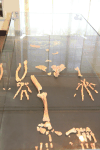
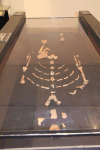
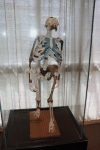
From the Wikipedia entry for Sterkfontein:
Sterkfontein (Afrikaans for Strong Spring) is a set of limestone caves of special interest to paleo-anthropologists located in Gauteng province, about 40 km (25 miles) northwest of Johannesburg, South Africa in the Muldersdrift area close to the town of Krugersdorp. The archaeological sites of Swartkrans (Afrikaans for Black Cliff) and Kromdraai (Afrikaans for Crooked Turn) are in the same area. Sterkfontein is a South African National Heritage Site and the area in which it is situated, was named the Cradle of Humankind.
Numerous early hominin remains have been found at the site over the last few decades. These have been attributed to Australopithecus, early Homo and Paranthropus.
Homo naledi is an extinct species of hominin, which anthropologists first described in 2015 and have assigned to the genus Homo. In 2013, fossil skeletons were found in the Gauteng province of South Africa, in the Rising Star Cave system, part of the Cradle of Humankind World Heritage Site about 50 km (31 miles) northwest of Johannesburg. Prior to dating, initial judgment based on archaic features of its anatomy favored an age of roughly two million years old. In 2017, however, the fossils were dated to between 335,000 and 236,000 years ago, long after much larger-brained and more modern-looking hominins had appeared. The research team therefore thinks that H. naledi is not a direct ancestor of modern humans, although it is probably an offshoot within the genus Homo.
The species is characterized by a body mass and stature similar to small-bodied human populations, a smaller endocranial volume similar to Australopithecus, and a skull shape similar to early Homo species. The skeletal anatomy presents ancestral features known from australopithecines with more recent features associated with later hominins. As of 10 September 2015, fossils of at least fifteen individuals, amounting to more than 1550 specimens, have been excavated from the cave. Newer findings (remains of at least three individuals: two adults and a child) in a second chamber, known as Lesedi ("light" in the Sotho-Tswana languages), were reported by Hawks et al. (2017).
The fossils were discovered by recreational cavers Rick Hunter and Steven Tucker in 2013. Homo naledi was formally described in September 2015 by a 47-member international team of authors led by American-born South African paleoanthropologist Lee Berger of the University of the Witwatersrand, who proposed the bones represent a new Homo species. Other experts contend more analyses are needed to support this classification. There are some indications that the individuals may have been placed in the cave near the time of their death.
Fossil Hominid Sites of South Africa are a UNESCO World Heritage Site.

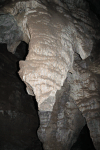
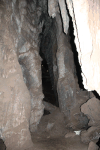

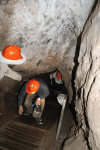

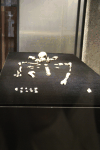




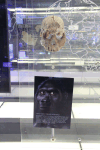
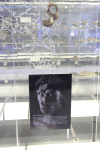
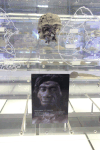
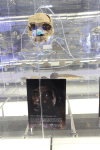



This page contains 29 pictures with 12 species
 Main page for Ethiopia |  Main page for South africa |  Main page for Tanzania |
Page last updated on Fri May 21 14:49:49 2021 (Mountain Standard Time)
Page last updated on Wed Apr 24 03:59:27 2024 (Mountain Standard Time)
Human Ancestors on aerobaticsweb.org